

Internet architecture and the layers principle: a conceptual framework for regulating Bitcoin. Abstract Bitcoin is the first decentralised, peer-to-peer network that allows for the proof and transfer of ownership of virtual currencies without the need for a trusted third party.
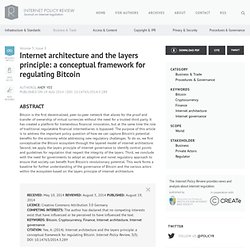
It has created a platform for tremendous financial innovation, but at the same time the role of traditional regulatable financial intermediaries is bypassed. The purpose of this article is to address the important policy question of how we can capture Bitcoin’s potential benefits for the economy while addressing new regulatory challenges. To do so, we first conceptualise the Bitcoin ecosystem through the layered model of internet architecture. State of Bitcoin Q2 2014. White Paper – Complete Payment Methodology – Management Tool for Bitcoin or Any Cryptocurrency – Proof of Work. Software Requirements Specification Template Currency Adjustment Factor for Bitcoin Program – Spring 2014 – By Brent Woods Currency Adjustment Factor for Bitcoin or Any Alt Coin Project – Complete Payment Methodology Program & Management Tool Software Requirements Specification March 8, 2014 Brent Woods Lead Software Engineer Spring 2014 Revision History Date Description Author Comments <date> <Version 1> <Your Name> <First Revision>

Could Bitcoin be as transformational as the World Wide Web? Formalizing and Securing Relationships on Public Networks.
Nick Szabo's Home Page. Bitcoin and the Three Laws of Robotics. By Stan Larimer, President, Invictus Innovations, Inc.
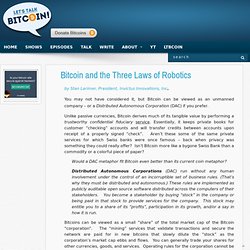
You may not have considered it, but Bitcoin can be viewed as an unmanned company – or a Distributed Autonomous Corporation (DAC) if you prefer. Unlike passive currencies, Bitcoin derives much of its tangible value by performing a trustworthy confidential fiduciary service. Essentially, it keeps private books for customer “checking” accounts and will transfer credits between accounts upon receipt of a properly signed “check”. Aren’t these some of the same private services for which Swiss banks were once famous – back when privacy was something they could really offer? Storage/On the Origins of Bitcoin Graf 03.11.13.pdf. Mastering Bitcoin - Community Outline Review.
Www.chicagofed.org/digital_assets/publications/chicago_fed_letter/2013/cfldecember2013_317.pdf. Jon Matonis (jonmatonis) Eprint.iacr.org/2012/596.pdf. Can We Afford Integrity by Proof-of-Work? Scenarios Inspired by the Bitcoin Currency by Jörg Becker, Dominic Breuker, Tobias Heide, Justus Holler, Hans Peter Rauer, Rainer Böhme. Jörg Becker University of Muenster - Department of Information Systems Dominic Breuker Tobias Heide Justus Holler Hans Peter Rauer Rainer Böhme.
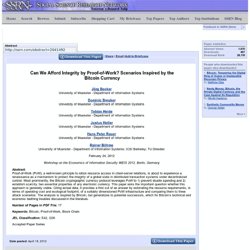
Crypto.stanford.edu/~xb/fc12/bitcoin.pdf. Bitcoin: Tempering the Digital Ring of Gyges or Implausible Pecuniary Privacy by Matthew Elias. Affiliation not provided to SSRN October 3, 2011 Abstract: Bitcoin is a peer-to-peer cryptocurrency; which is entirely decentralized, open-source, and non-institutional.

A comprehensive history of Bitcoin transactions is constantly distributed among users, while partial anonymity is accomplished through public/private key transactions. Bitcoin differs from digital currencies like Zynga, Second Life, and E-Gold, because no central authority issues new currency, instead it is ‘mined’ by self-interested individuals. States have an interest in regulating Bitcoin, due to its purported desirability as a medium for funding the drug trade, terrorism, and other subversive activities. Bitcoin’s architecture will encourage continued adoption, which will result in mounting pressure on the legal systems of interested states to codify a solution. The architecture of the internet leads individuals to perceive themselves as having a greater degree anonymity when online. Number of Pages in PDF File: 35. Papers/BitcoinBreachesGreshamsLaw.pdf.
[1107.4524] An Analysis of Anonymity in the Bitcoin System. Extending real-world laws to virtual worlds is a terrible idea – Lex Technologiae. Governments shouldn’t interfere with the internal regulations of virtual worlds.
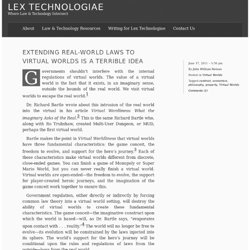
The value of a virtual world is the fact that it exists, in an imaginary sense, outside the bounds of the real world. We visit virtual worlds to escape the real world. Dr. Www.hiit.fi/u/vlehdonv/documents/Lehdonvirta-2010-virtual-goods-regulation.pdf. Download Attachment. Category:Alternative currencies. List of community currencies in the United States. Www.greenleaf-publishing.com/content/pdfs/TNT_bendell.pdf. Shinichi Mochizuki@RIMS. Regulating Digital Currencies: Bringing Bitcoin within the Reach of the IMF by Nicholas Plassaras. University of Chicago April 7, 2013 Chicago Journal of International Law, 14 Chi J Intl L (2013) Forthcoming Abstract: This paper examines the potentially destabilizing effects of emerging digital currencies on the international foreign currency exchange.

Specifically, it examines “Bitcoin,” a decentralized, partially anonymous, and largely unregulated digital currency that has become particularly popular in the last few years. The paper argues that the International Monetary Fund, the institution responsible for coordinating the stability of foreign exchange rates, is ill-equipped to handle the widespread use of Bitcoins into the foreign exchange market. It highlights the inability of the Fund to intervene in the event of a speculative attack on a currency by Bitcoin users. Bitcoins. Economics of Bitcoin. Dev.economicsofbitcoin.com/mastersthesis/mastersthesis-surda-2012-11-19b.pdf.
Bitter to Better — How to Make Bitcoin a Better Currency. Bitter to Better — How to Make Bitcoin a Better Currency. Bitcoin Schemes- inovation or a threat to Financial Stability? Abstract A virtual currency can be defined as a type of unregulated, digital money, which is issued and usually controlled by its developers, and used and accepted among the members of a specific virtual community.
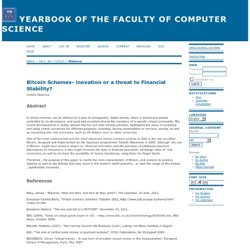
The recent developments in widely spread internet and data mining activities, highlighted the issue of accepting and using virtual currencies for different purposes, including, buying commodities or services, saving, as well as converting into real currencies, such as US dollars, euro or other currencies. One of the most controversial and the most advanced virtual currency scheme to date is the one so-called Bitcoin, designed and implemented by the Japanese programmer Satoshi Nakamoto in 2009. Therefore , the purpose of this paper to clarify the main characteristic of Bitcoin, and analyze its positive aspects as well as the threats that may occur to the modern world economy , in case the usage of this money , significantly increases .
References. [1304.4758] Bitcoin and Beyond: Exclusively Informational Monies. Nicholas Plassaras. Changethis.com/manifesto/104.01.PresentShock/pdf/104.01.PresentShock. Hal Finney Home Page. Bitcoin and me (Hal Finney) I thought I'd write about the last four years, an eventful time for Bitcoin and me.

For those who don't know me, I'm Hal Finney. I got my start in crypto working on an early version of PGP, working closely with Phil Zimmermann. When Phil decided to start PGP Corporation, I was one of the first hires. I would work on PGP until my retirement. At the same time, I got involved with the Cypherpunks. Fast forward to late 2008 and the announcement of Bitcoin. When Satoshi announced Bitcoin on the cryptography mailing list, he got a skeptical reception at best. I was more positive. When Satoshi announced the first release of the software, I grabbed it right away.
Hal Finney (cypherpunk) Hal Finney (born May 4, 1956) is a developer for PGP Corporation, and was the second developer hired after Phil Zimmerman.

In his early career, he is credited as lead developer on several console games (Adventures of Tron, Armor Ambush, Astroblast, Space Attack).[1] He is a 1979 graduate of the California Institute of Technology, holding a BS in engineering. Finney is also a noted cryptographic activist.[2] During the early 1990s, in addition to being a regular poster on the cypherpunks listserv, Finney ran two anonymous remailers.[3] Further cryptographic activism included running a (successful) contest to break the export-grade encryption Netscape used.[4] In 2004, Finney created the first reusable proof of work system before Bitcoin. [citation needed][5] In January 2009, Finney was the Bitcoin network's first recipient transaction.[6] George Selgin. George A. Selgin (/ˈsɛldʒɪn/; born 1957) is a professor of economics in the Terry College of Business at the University of Georgia, a senior fellow at the Cato Institute in Washington DC, and an associate editor of Econ Journal Watch.[1] Selgin formerly taught at George Mason University, the University of Hong Kong, and West Virginia University.
Life and career[edit] Selgin's principal research areas are monetary and banking theory, monetary history, and macroeconomics. George Selgin Website.